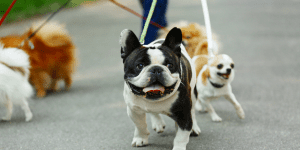How To Use A Long-Line Lead In Dog Training.
Using a long-line for your dog is a great way to give your dog freedom, while still retaining control over what they are doing. It is also a really effective way to help teach your dog a good recall before letting him, or her, off the lead completely. If you are keen to know more about how to use a long-line lead in dog training – read our Holidays4Dogs article.
A long line is simply that – a long length of lead which attaches to your dog’s harness. The length of the line can be as long as you want it. They can be purchased in various lengths from 2-3 metres up to 20 metres, or more.
Lone lines are usually more robust than retractable leads and come in different types of material. A popular material for dog leads is that of nylon webbing. However, while robust, they aren’t as soft on the hands and they can soak up wet and mud readily.
Another material, commonly used in canine and equestrian sports, is made with a rubber BioThane coating. This makes the material resistant to water and rot.
Therefore, it does not become heavy and stinky when used in inclement weather conditions. Leads made from BioThane are durable pliable and pleasant to handle, having the look and feel of leather.
You can buy lines with, or without, handle loops. Some people prefer ones without a handle on the end, as these are less likely to snag on rocks or branches when left to drag on the ground.
Why use a long line?
Long lines are brilliant for allowing your dog to have more freedom while still keeping him, or her, safe. They are great for allowing dogs that don’t have a great recall – or cannot be let off the lead for other reasons – to investigate the world around them in their own time. They are also great training tools and can help with various aims such as teaching recall, or helping a reactive dog to socialise.
Tips for using a long-line lead.
Attach the long line preferably to a harness, rather than a collar. By using a harness, you can prevent injury to your dog should he suddenly run to the end of the lead at speed.
You will be using both hands to hold the lead. Gather the lead up in loose loops, in whichever hand you feel most comfortable with. With the other hand hold the line nearest to the dog.
As your dog moves forward, let out some of the loops. Allow the line to slip slowly through the other hand. This way, you will be able to slow your dog down – thereby reducing the chance of your dog being stopped too harshly. By using two hands it also means you are less likely to accidentally let go of the lead.
If you are using the line for training recall skills – once the dog is responding better – drop your end of the lead. This can provide you with more confidence since you can grab the lead again, if things go wrong. Once you are completely confident your dog will respond, you will be able to allow your dog off-led altogether.
If you are new to long lines, a 5-10 metre in length lead would suffice. This will be easier to handle and is less likely to end up tangling you – or your dog – up in knots!
Other points to think about when using a long line.
Long lines are excellent training tools and good for giving your dog more freedom in open spaces. However, there are some hazards to be aware of;-
Be aware of how much slack your dog has. Too much length in the wrong environment may mean you can’t take up the slack quickly enough.
It is especially important to keep long lines short when your dog is meeting strange dogs, or around other walkers. Tangling is one of the downsides of long lines, so it is essential you don’t let the lead become entangled round other dogs, or people as this could cause conflict.
Do keep an eye on your dog all the time and let the slack in and out, accordingly. Be watchful of your dog suddenly taking off and hurting himself, or your hands. For added security you could consider tying the handle end around your waist. Gather the remaining loops in the same way. This way if you do accidentally drop the lead, your dog is still attached to you.
If your walk takes you through busier areas, always carry a short lead to use instead.
Never use a long line as a tie-out and never leave your dog unattended on one. Dogs can still bite through long leads.
Conclusion.
Long lines are a great bit of kit if you’re a dog owner. They give dogs much more freedom than being on a shorter lead and can provide dogs with a lot more mental enrichment. This is particularly important for dogs that must be on the lead at all times.





